
- Search forums
Follow along with the video below to see how to install our site as a web app on your home screen.
Note: This feature may not be available in some browsers.
- Star Trek Series | 2364 - 2378
- Star Trek: Voyager

Star Trek Voyager Opening Title Sequence Recreated with CGI in 4k!
- Thread starter PixelMagic
- Start date Aug 11, 2017
Fleet Captain
- Aug 11, 2017
Vice Admiral
- Aug 12, 2017
You know every time I watch Voyager I wait for the part of the sequence just at the end where she almost steadies and then goes to warp in a stream............. That was great! Stunning ship.
Bad Batch of TrekBBS
I would've removed the reflection on that ring
I've always thought Voyager had the best opening sequence.
Just saw this appear on my YouTube recommendations. Awesome job!
- Aug 13, 2017
That’s beautiful. For the techies, what did he do?
- Aug 16, 2017
Phaser Two said: That’s beautiful. For the techies, what did he do? Click to expand...
Also, this is gorgeous. The work Foundation Imaging et al did on Trek back in the '90s was a big influence on my wanting to work in VFX. Seeing this in 4K brought chills.
Burning Hearts of Qo'nOs
- Aug 17, 2017
This is lovely! However, the placement of the text for the cast is driving me a little nuts.
Gepard said: Recreate it from scratch in Lightwave. There's some details in the video description. Click to expand...
Matthew Raymond
Finn said: I would've removed the reflection on that ring Click to expand...
Even as a kid I thought...the size of that planet can't possibly be right... They should have made THAT episode, just a quiet survey mission on an impossibly tiny planet A-story and maybe some crew interaction B-story. The theme could just have been little stories between pairs or threes.
tomswift2002
- Aug 18, 2017
Burning Hearts of Qo'nOs said: This is lovely! However, the placement of the text for the cast is driving me a little nuts. Click to expand...
tomswift2002 said: How? The guy just placed them where they would've been placed had Voyager been done in 16:9. Click to expand...
Space Police
I don't like this at all, it looks awful! Every shot feels artificial and obviously fake.
- Aug 19, 2017
Burning Hearts of Qo'nOs said: A couple of them are way too close to the edges of the screen for my taste. Offhand without watching it again I think Seven's was the one that stood out. Click to expand...
To Ꝏ & Somewhere..!
- Sep 8, 2017
Similar threads
- Jun 29, 2024
- General Trek Discussion
- Aug 25, 2024
- Star Trek Movies I-X
- Dec 17, 2023
- Shat Happens
- Dec 4, 2023
- Star Trek: The Next Generation
- Gingerbread Demon
- Sep 10, 2024
Sign up / Register
- Star Trek: Enterprise
- Star Trek - The Original & Animated Series
- Star Trek: Deep Space Nine
- Star Trek: Discovery
- Star Trek: Picard
- Star Trek: Strange New Worlds
- Star Trek: Lower Decks
- Star Trek: Prodigy
- Star Trek Movies: Kelvin Universe
- Future of Trek
- Trek Gaming
- Trek Literature
- Fan Fiction
- Fan Productions
- CSI (at Talk CSI)
- Science and Technology
- Sports and Fitness
- Web Sites/Design
- Miscellaneous
- Site Forums

Subscribe to Updates
Get the latest creative news from FooBar about art, design and business.
By signing up, you agree to the our terms and our Privacy Policy agreement.
James Cameron Hopes That The Upcoming Terminator Film Will Be Unlike Any Other
At last, our stunning first look at mickey 17, bong joon ho’s upcoming science fiction film, the star wars jedi trilogy will come to an end in the next game.

Every STAR TREK Opening Theme Song Ranked from Worst to Best
Find out which is the greatest opening in Star Trek television history. Star Trek is the most iconic television show ever. It’s also spawned one of the most successful movie franchises ever made.
Part of its success is the Star Trek theme song. The original song is so iconic people know it even if they’ve never seen an episode of the show. Over the years there have been many spin-offs of the show which each used a new theme song. Some have been brilliant and some have been horrible.
Most recently Star Trek: Discovery is airing on CBS All-Access . Soon the upcoming Picard series will introduce a new theme song. We don’t know if the opening for Picard will match up with some of the others. But it’s time to look back at the history of the Star Trek opening songs and rank them from worst to best.
Make it so.
11. Star Trek: Enterprise Season 3-4 (2003–2005)
Composed by Dennis McCarthy
Enterprise’s theme song is the first (and last) time Star Trek uses a contemporary song for the opening. Dennis McCarthy scored the pilot episode. Executive producer Rick Berman promised something new for Star Trek’s sixth spin-off series. He said the opening would “be using a little bit more contemporary kind of music. […] It’s not all of a sudden that the show is going to be scored with electric guitars. It’s going to be a little hipper.”
The song “Faith of the Heart” is written by Diane Warren and sung by Rod Stewart for Robin Williams’ comedic-drama Patch Adams (1998). The song was a hit and charted at number three on the US Hot Adult Contemporary Tracks and number 60 on the UK Singles Chart. It’s used for Star Trek and sung by Russell Watson . It’s a good song and some of the lyrics match up with the idea of space travel.
You have to inspire the courage of the producers for trying something new but it doesn’t work. There’s a tradition of Star Trek shows opening with a grand orchestral theme. This song sounds like a Rod Stewart concert. After fans complained the song is different in the third and final season of Enterprise .
The new version has a higher pitch and is sped up. They added tambourine and a more pronounced electric guitar. Star Trek managed to make a bad decision even worse.
10. Star Trek: Enterprise Season 1-2 (2001–2002)
Dennis McCarthy first made music for the Next Generation pilot episode and scored dozens of other episodes. McCarthy later composed the theme for the shows Deep Space Nine and Voyager. Plus he scored the soundtrack for movies like Star Trek: Generations .
The opening of Enterprise uses the song “Faith of the Heart” sung by British crossover opera singer Russell Watson. Fans hated it so much that fans created many petitions to get rid of it. “[We] urgently request that you remove [‘Faith of the Heart’] and in its place utilize a score that is without vocals, as traditionally used by [the] ‘Star Trek’ television series,” one petition said.
“We wish to express our unmitigated disgust with the theme song that has been selected for the new ‘Enterprise’ series,” another online petition said. “It is not fit to be scraped off the bottom of a Klingon’s boot.”
“I’m in the horrible minority of people who like the song,” Rick Berman defended the song telling Sci-Fi Wire . “I think it fits beautifully. I think it’s a song that’s got a lot of hopefulness and uplifting qualities to it. And I like it. I’ve met a lot of other people who like it, but I’ve also heard a tremendous amount of banter about people who don’t. And what’s a Star Trek series without something for people to hate?”
Whatever you think of the song it was used as a wakeup call for NASA missions .
9. Star Trek: Enterprise Season 4 “Mirror Darkly” (2005)
Composed by Dennis McCarthy & Kevin Kiner
In 2005 the series Enterprise traveled to an alternate “evil mirror universe” for several episodes. To complete the feel that the show had traveled to another world they changed the opening. The theme song has a more militaristic tone and a darker feel.
It works well, especially when shown along with images showing how Earth entered into a long-standing war. Considering it replaced a pop song it’s even more impressive. Unfortunately, it only lasted a few episodes before going back to “Faith of the Heart”.
8. Star Trek: Discovery (2017-2019)
Composed by Jeff Russo
When CBS started work on the Star Trek prequel Star Trek: Discovery they hired Jeff Russo to compose a new opening theme. Russo has started in a ’90s alternative rock band named “Tonic”. After that, he started composing songs for video games and television shows. He won an Emmy for his work on the FX series Fargo .
He describes himself as a life-long fan of Star Trek and Jerry Goldsmith’s work on The Next Generation in particular. The theme for Discovery sets itself apart because they decided to focus on emotion rather than exploration. It starts with the familiar fanfare for Star Trek and then uses stringed instruments to give a sense of mystery and hope. It ends with the theme again which implies the future of the franchise.
It’s a solid piece that relies on fan recognition. So it doesn’t stand out on its own.
7. Star Trek: The Original Series (1966–1969)
Composed by Alexander Courage
The theme for Star Trek played over every episode in the show’s three seasons. It’s called “Where No Man Has Gone Before”. It’s an instrumental piece and opens with a monologue by William Shatner starting with “Space. The final frontier”. The song itself relied on wind instruments and percussion by bongo drums, which was a popular instrument at the time.
Alexander Mair “Sandy” Courage Jr. was an Academy Award-nominated, Emmy Award-winning composer, arranger, conductor, and orchestrator of television shows and movies like Jurassic Park (1993), Star Trek: First Contact (1996), and Hello, Dolly! (1964).
Courage was inspired by the Richard Whiting song “Beyond the Blue Horizon,” giving him the idea for a song which was a “long thing that…keeps going out into space…over a fast-moving accompaniment.”
The original song is a masterpiece of its time evoking a feel of adventure and excitement and has been used in several pieces for Star Trek since then. Unfortunately, it feels dated. Bongo drums fell out of fashion decades ago. The operatic singing by Loulie Jean Norman feels out-of-place. Iconic, but not quite as good as others.
6. Star Trek: The Animated Series (1973–1974)
Composed by Ray Ellis (Yvette Blais), Norm Prescott (Jeff Michaels)
Raymond Spencer Ellis arranged many hit records in the 1950s and 1960s. He later started working with Filmation on their animated series. He used his wife’s name “Yvette Blais” as a pseudonym. Norman Prescott was co-founder and executive producer at Filmation Associates and worked with Ellis on the theme song. He used the pseudonym “Jeff Michael” after his sons Jeff and Michael.
Paramount decided to revive the original series for a Saturday morning cartoon. They decided to make the theme more modern.
Like the original song, it starts with Shatner’s monologue “where no man had gone before”. Then it moves onto a song with a much faster pace and tone than the original. The tone is slightly different as well but manages to capture the same feel of the original song. Plus, there’s no singing.
5. Star Trek: Deep Space Nine Season 1-3 (1993–1995)
Jerry Goldsmith was contacted to do the theme song but declined because of scheduling problems. Dennis McCarthy has done a ton of work on Star Trek and he admired the Star Trek: The Next Generation song. He said that he loved the trumpets and French horns in the theme so McCarthy used wind instruments to write the song for DS9 .
It’s different from other songs because it’s the first show to focus on a starbase instead of a spaceship. So the feel of the song is very different for the fourth television spin-off. Berman said he wanted to emphasize the loneliness of the station. McCarthy told SyFy he wanted the theme to say, “We are alone” and he accomplished it. It’s different but beautiful. In 1993 he won an Emmy for “Outstanding Individual Achievement in Main Title Theme Music” on DS9.
4. Star Trek: Picard (2019-)
Composed by Jeff Russo
CBS All Access went in a different direction with the theme song for Picard. Instead of relying on strings and a large orchestra to play the song it goes smaller. The song is thoughtful, serene and melodic. It’s not bombastic like the N ext Generation theme or slow like Deep Space Nine.
But it does owe a debt to the 90s Star Trek series. In the TNG episode “The Inner Light” Picard is knocked unconscious by an alien probe. He lives 40 years of life as an alien scientist named Kamin in the span of a few minutes. During the episode, he hears a flute song played by his “son” Batai (Daniel Stewart). After Picard returns to his normal life, he still remembers how to play and plays a melody on a flute. That flute and song have a special place in Picard’s life since it’s the family he never had but “lost”. It’s not a coincidence. The composer said he wanted to use a flute to evoke some of the feelings from the episode.
Russo told The Ready Room he wanted to “change to a feeling of emotional contentment for him because as we come to see, he lives on a chateau. And it’s sort of what we always thought would happen at the end of The Next Generation, and those movies where he would always sort of end up … That was his happy place. And then I wanted to … evoke how he has been awoken again.”
It ends with a small section of the theme from Star Trek: The Next Generation . It’s lovely, thoughtful and moving.
3. Star Trek: Deep Space Nine Season 4-9 (1996–1999)
For the fourth season to the final season, the song changed. It’s actually better in many ways. The show had changed by the fourth season. New characters joined the show like Leeta (Chase Masterson) the Dabo girl. Other characters, like Worf (Michael Dorn) from Next Generation, returned. The starship USS Defiant was added to allow the show to travel to different parts of space.
All these changes led the producers and McCarthy to rework the theme song to make it lighter. The reworked song makes the show brighter and gives more hope. Star Trek is all about hope and it fits wonderfully.
2. Star Trek: Voyager (1995–2001)
Composed by Jerry Goldsmith
Jerry Goldsmith is a legend in the industry with a long list of awards including 18 Academy Award nominations. He won an Oscar for The Omen (1976) and was nominated for Star Trek: The Motion Picture in 1979.
Unlike The Next Generation which used music from his movie Star Trek: The Motion Picture, he decided to write a new song. The song is a beautiful sweeping theme that has stunning pictures of the ship soaring through space. The Voyager theme is somber and lonely but not sad. It’s uplifting.
The Voyager opening theme song is wonderful.
1. Star Trek: The Next Generation Season 1-7 (1987–1994)
Composed by Dennis McCarthy, Jay Chattaway, Ron Jones, Alexander Courage, Jerry Goldsmith
When the producers were planning out the first Star Trek show in decades they wanted to make sure the music would meet fan expectations. So they turned to the work of Jerry Goldsmith and used a piece from Star Trek: The Motion Picture. Specifically, they took a piece that played several times in the soundtrack. The first time is before the Enterprise’s first warp test.
The song is perfect for the opening as it has a feel of hope and majesty. The original song was performed by a 100-piece orchestra. Too much for a TV show so they scaled it back and McCarthy led the original orchestration of a slightly different version of the song.
It opens with the opening of the original Star Trek theme. Then Patrick Stewart says a version of the “Where no man has gone before” monologue. After that, the song begins and blows the doors off. It’s the best theme Star Trek has ever had and set the standard for all other openings.
Which is your favorite Star Trek theme song? Which one do you hate? Let us know in the comments below!
Note: Some links may lead to an approved affiliate and small proceeds from the sale go to support the blog. Thank you!
If you enjoyed this, then please use the buttons below to tell your friends about this post! Follow us! Email | RSS | Twitter | Facebook
- X (Twitter)
Star Trek: Voyager
Star Trek: Voyager is the fifth Star Trek series. It was created by Rick Berman , Michael Piller , and Jeri Taylor , and ran on UPN , as the network's first ever series, for seven seasons in the USA , from 1995 to 2001 . In some areas without local access to UPN, it was offered to independent stations through Paramount Pictures , for its first six seasons. The series is best known for its familial crew, science fiction based plots, engaging action sequences, and light humor. The writers often noted that many episodes had underlying themes and messages or were metaphors for current social issues. This is the first Star Trek series to feature a female captain in a leading role. However, Kathryn Janeway herself is not the first female captain to be seen within Star Trek as a whole. Additionally, the show gained in popularity for its storylines which frequently featured the Borg . Voyager follows the events of Star Trek: The Next Generation and ran alongside Star Trek: Deep Space Nine during its first five seasons.
- 1 Series summary
- 2 Distinguishing Voyager
- 3 Reception
- 4.1 Starring
- 4.2 Also starring
- 5 Executive producers
- 6 Opening credits
- 7.1 Season 1
- 7.2 Season 2
- 7.3 Season 3
- 7.4 Season 4
- 7.5 Season 5
- 7.6 Season 6
- 7.7 Season 7
- 8 Related topics
- 9 Syndication
- 11 External links
Series summary [ ]
Launched in the year 2371 , the Intrepid -class Federation starship USS Voyager was a ship built to return to Starfleet 's founding principle of scientific exploration. It was fitting that the ship's captain , Kathryn Janeway , rose up through the science ranks rather than command. On the ship's first mission while departing the space station Deep Space 9 , which required it to find and capture a Maquis vessel that disappeared into the treacherous Badlands , the crew of Voyager , as well as that of the Maquis ship it was pursuing, were swept clear across the galaxy and deep into the Delta Quadrant . This was the doing of a powerful alien being known as the Caretaker . The seventy thousand light year transit cost the lives of over a dozen crew members. Captain Janeway was forced to destroy the massive alien array that housed the remains of the Caretaker. In doing so, she saved an alien race, the Ocampa , but stranded Voyager and the crew in the Delta Quadrant.
United in a common purpose, the surviving Maquis rebels joined with Janeway's Starfleet-trained crew on Voyager . Though a journey back to the Alpha Quadrant would have taken more than seventy years through unknown and treacherous territory , the crew of Voyager was well served by Janeway's skilled leadership and their own steadfast determination. Ultimately, Voyager returned to the Alpha Quadrant in seven years.
The crew's journey home was eventful. Voyager made first contact with over four hundred completely new species in the Delta Quadrant, discovered links to Earth 's early space exploration history , utilized and even pioneered new technologies, all the while engaging in countless other adventures. (" Distant Origin ")
The crew encountered species ranging from the violent and ruthless Kazon , the Phage -afflicted Vidiians , the colorful Talaxians and the ephemeral Ocampa . The crew's other encounters included run-ins with the temporal sophistication of the Krenim , the predatory Hirogen , the toxic Malon and the scheming Hierarchy . The crew picked up passengers along the way, including the wily but extremely resourceful Talaxian Neelix (who served, at times, as Voyager 's ambassador , morale officer , and even head chef ), along with the Ocampan telepath Kes (who, as a parting gift to the crew, used her powers of telekinesis to thrust Voyager 9,500 light years closer to the Alpha Quadrant).
Most memorable, however, were Voyager 's repeated clashes with the dreaded Borg . While each encounter posed grave danger, Voyager was able to prevail every time. At one point, Janeway actually negotiated a temporary peace with the Borg when they perceived a common threat in a mysterious alien species from fluidic space . (" Scorpion ") At other times, she was able to liberate drones from the Borg Collective , including Seven of Nine (who became a permanent member of the crew), Mezoti , Azan , Rebi , and Icheb . Other instances pitted Voyager against not only the Borg, but also against the nightmarish Borg Queen herself.
Several years after Voyager 's disappearance into the Delta Quadrant, Starfleet Command learned of the starship's fate. Subsequently, the Pathfinder Project was created, a Starfleet Communications project that attempted to communicate with Voyager through the MIDAS array , via a micro-wormhole and the Hirogen communications network . Thanks to the hard work and enthusiasm of Lieutenant Reginald Barclay , the communications technology improved to a level whereby contact could be made on a regular basis. In 2377 , the crew was able to receive monthly data streams from Earth that included letters from the crew's families, tactical upgrades, and news about the Alpha Quadrant.
By the end of the year, Voyager made a triumphant return to the Alpha Quadrant, under the guidance of Starfleet and the Pathfinder Project, by utilizing and then destroying a Borg transwarp hub , and after a turbulent trip, a celebration was held in honor of Voyager 's return back home.
Distinguishing Voyager [ ]
Despite the general prosperity of Star Trek: Deep Space Nine , Paramount pressured Rick Berman for yet another Star Trek television series. Although it was decided very early on that the new series would be set aboard a starship once again, it was important for the writers to vary the series from Star Trek: The Next Generation in other ways. Berman stated, " When Voyager came around and we knew we were going to place the next series back on a starship we wanted to do it in a way that was not going to be that redundant when it came to The Next Generation . So we had a certain amount of conflict on the ship because of the Maquis. We had a different dynamic because we were not speaking every day to Starfleet and because we had a female captain. Those were the major differences that set this show apart from the others… It had the core belief of what Star Trek was all about, both in terms of the excitement and the action and in terms of the provocative elements of ideas that Star Trek has always been known to present to the audience. " ( Star Trek: Voyager Companion , p. ? )
The series' premise of being lost in deep space was itself a variation on a theme explored in The Next Generation . Michael Piller explained, " We remembered the episodes, many episodes, where Q would show up and throw one of our ships or one of our people off to a strange part of the universe. And we'd have to figure out why we were there, how we were going to get back, and ultimately – by the end of an episode – we'd get back home. But […] we started to talk about what would happen if we didn't get home. That appealed to us a great deal […] You have to understand that Rick, Jeri and I had no interest in simply putting a bunch of people on another ship and sending them out to explore the universe. We wanted to bring something new to the Gene Roddenberry universe. The fans would have been the first people to criticize us if we had not brought something new to it. But everything new, everything was… a challenge, in the early stages of development of Voyager." ("Braving the Unknown: Season 1", VOY Season 1 DVD special features)
Jeri Taylor concurred that Voyager had to be different from its predecessors. She stated, " We felt a need to create an avenue for new and fresh storytelling. We are forced into creating a new universe. We have to come up with new aliens, we have to come up with new situations. " Taylor also recalled, " We knew we were taking some risks. We decided, in a very calculated way, to cut our ties with everything that was familiar. This is a dangerous thing to do. There is no more Starfleet, there are no more admirals to tell us what we can and cannot do, there are no Romulans, there are no Klingons, there are no Ferengi, no Cardassians. All those wonderful array of villains that the audience has come to love and hate at the same time will no longer be there. This is a tricky thing to do. " ("Braving the Unknown: Season 1", VOY Season 1 DVD special features)
Differentiating the new series from what had gone before hardened the challenge of inventing the series' main characters. Jeri Taylor recounted, " It took a long, long time, it took us weeks and weeks and weeks, even to come up with a cast of characters, because we found that so many wonderful characters had already been done and we didn't want to exactly repeat ourselves. We'd come up with an idea then say, 'No, that's too much like Data ,' or, 'That's too much like Odo ,' or, 'That's too much like Worf .' So to try to find the right balance of characters, in terms of gender and alien species and that kind of thing, really took a long time. " ("Braving the Unknown: Season 1", VOY Season 1 DVD special features)
↑ John Van Citters listed "VGR" as the series' official abbreviation when announcing the "DSC" abbreviation for Star Trek: Discovery . [1] MA , among other venues, will continue to use the abbreviation VOY for Voyager , for historical reasons.
Reception [ ]
During its seven-year run, Star Trek: Voyager was nominated for 34 Emmy Awards , mostly in "technical" categories such as visual effects and makeup. It won seven, including "Outstanding Individual Achievement in Main Title Theme Music" for Jerry Goldsmith 's theme.
Main cast [ ]
Starring [ ].
- Kate Mulgrew as Captain Kathryn Janeway
Also starring [ ]
- Robert Beltran as Commander Chakotay
- Roxann Biggs-Dawson as Lieutenant B'Elanna Torres
From the 12th episode of the 3rd season onward, Biggs-Dawson was credited as Roxann Dawson.
- Jennifer Lien as Kes ( 1995 - 1997 )
- Robert Duncan McNeill as Lieutenant Tom Paris
- Ethan Phillips as Neelix
- Robert Picardo as The Doctor
- Tim Russ as Lieutenant Commander Tuvok
- Jeri Ryan as Seven of Nine ( 1997 - 2001 )
- Garrett Wang as Ensign Harry Kim
Executive producers [ ]
- Rick Berman – Executive Producer
- Michael Piller – Executive Producer (1995-1996)
- Jeri Taylor – Executive Producer (1995-1998)
- Brannon Braga – Executive Producer (1998-2000)
- Kenneth Biller – Executive Producer (2000-2001)
Opening credits [ ]
The opening credits for Star Trek: Voyager contained imagery of USS Voyager passing near various spatial phenomena.
Episode list [ ]
Season 1 [ ].
Season 1 , 15 episodes:
Season 2 [ ]
Season 2 , 26 episodes:
Season 3 [ ]
Season 3 , 26 episodes:
Season 4 [ ]
Season 4 , 26 episodes:
Season 5 [ ]
Season 5 , 25 episodes:

Season 6 [ ]
Season 6 , 26 episodes:
Season 7 [ ]
Season 7 , 24 episodes:
Related topics [ ]
- VOY directors
- VOY performers
- VOY recurring characters
- VOY studio models
- VOY writers
- Recurring characters
- Character crossover appearances
- Undeveloped VOY episodes
- Paramount Stage 8
- Paramount Stage 9
- Paramount Stage 16
Syndication [ ]
With five seasons, Voyager reached syndication in some markets airing in a daily strip on weekdays in most markets or as a weekly strip on weekends in selected markets, with the first cycle of episodes from the first five seasons began airing on 13 September 1999 , with the second cycle of episodes covering the 25 episodes of Season 6 and the final episode of Season 5 beginning on 13 November 2000 and the final cycle of episodes covering episodes of the final season and the final episode of Season 6 beginning on 25 October 2001 . Voyager was broadcast in syndication for four years until 12 September 2003 , with some stations continuing to carry Voyager after leaving syndication.
- Star Trek: Voyager novels
- Star Trek: Voyager comics (IDW)
- Star Trek: Voyager comics (Malibu)
- Star Trek: Voyager comics (Marvel)
- Star Trek: Voyager soundtracks
- Star Trek: Voyager on VHS
- Star Trek: Voyager on LaserDisc
- Star Trek: Voyager on DVD
External links [ ]
- Star Trek: Voyager at Wikipedia
- Star Trek: Voyager at Memory Beta , the wiki for licensed Star Trek works
- Star Trek: Voyager at the Internet Movie Database
- Star Trek: Voyager at TV IV
- Star Trek: Voyager at StarTrek.com
- 2 Daniels (Crewman)
- 3 Klingon augment virus
Star Trek Opening Credits Ranked
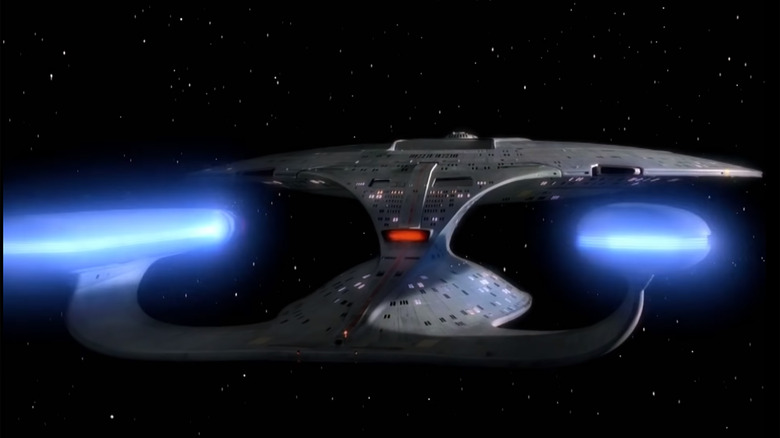
Every "Star Trek" series has a different theme and open credits sequence, all influenced by those that have come before. The original series featured a voice-over from William Shatner as Captain Kirk, explaining the mission of the Enterprise before the stirring music crescendos and the ship zooms off into space. Kirk's monologue has become a part of pop culture, and each series has tried to find a way to both pay homage to the original and tell their own story. As such, there are a wide variety of opening sequences, each trying to capture the themes and visuals of their specific show in a matter of minutes. Some are successful, with memorable, hummable themes that invoke a sense of nostalgia. Others are simply forgettable, while there are others still that I wish I could forget. With 11 different "Star Trek" TV shows in existence, there's quite a range of quality in their title sequences, so I've put together a handy ranking of them all, from the great to the truly terrible.
11. Enterprise
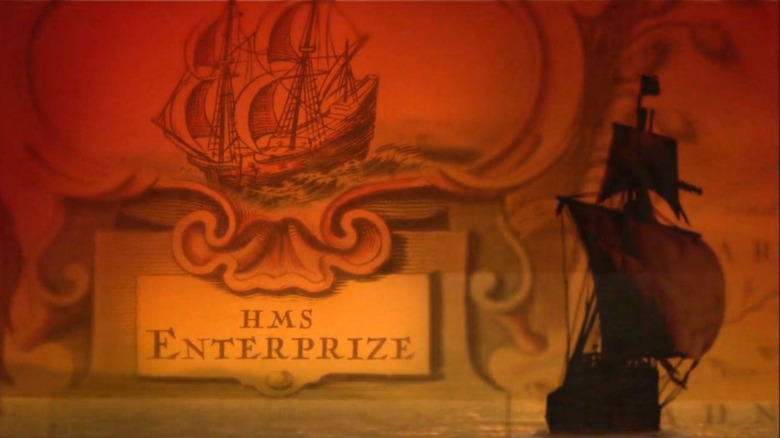
Music: "Star Trek: Enterprise" automatically loses points for being the only "Star Trek" opening with lyrics in its title music. While the other series feature an assortment of orchestral arrangements, for some mind-boggling reason the folks behind "Enterprise" decided to base the theme on a Rod Stewart song. "Where My Heart Will Take Me" by Russell Watson was adapted from "Faith of the Heart" by Rod Stewart, and it is corny . And if the song's weird sentimentality sounds familiar, that's because Stewart also wrote a version of "Faith of the Heart" for the Robin Williams movie "Patch Adams," which was notoriously sappy itself.
Visuals: Unfortunately, the visuals are just as dated and sentimental as the song choice, showing the history of exploration on Earth before we took to the stars. The idea is kind of cool, but it ends up looking like a NASA recruitment video more than the opening of a "Star Trek" series.
Trek Factor: While seeing the origins of exploration are neat, there's something about the misspelled "Enterprize" and the other various "old timey" elements that make the show feel weirdly dated, and not in an intentionally historical way. I imply cannot get over how hilariously late-'90s to early-'00s the intro feels, from the bizarre crossfades to the song that sounds a lot like the theme from "Firefly," which came out just a year after "Enterprise." Everything about it is trying to embody Americana, which feels oddly against the themes of intergalactic sharing of knowledge from the rest of "Star Trek." The whole thing feels corporate and sterile, and misses the point of "Star Trek" entirely.
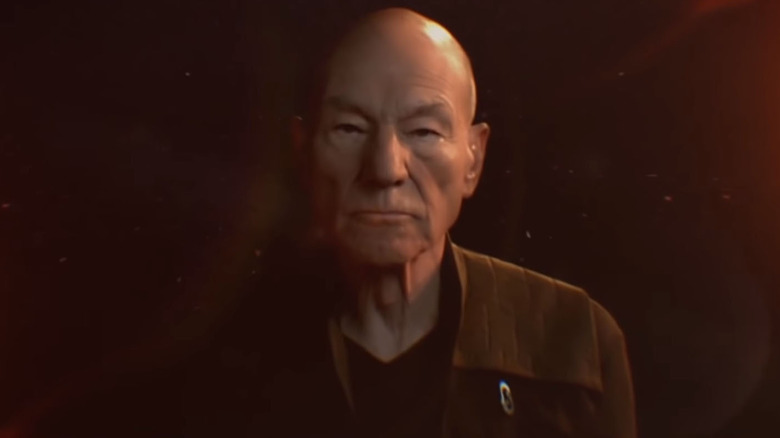
Music: The instrumental theme by Jeff Russo is pretty excellent, though it doesn't have the same rousing spirit as many of its forebears. Then again, " Picard " focuses on a man in his twilight years, and isn't about exploring the cosmos or defending a pivotal gateway between universes. It's a little more contemplative, a little more somber, and the theme reflects that with its gentle string arrangements and hints of the theme from "Star Trek: The Next Generation."
Visuals: "Picard" unfortunately falls into the recent trend of overlaying a bunch of images in a semi-psychedelic looking way to create a title sequence. The trend started with shows like "Hannibal" and "Nip/Tuck," though those had a unique conceit tied to their show, before eventually blowing up with the incredible title sequence on the first season of "True Detective." After that, everyone tried to mimic the style in their own way, and the opening titles to "Picard" feel more like an attempt at being relevant than staying true to "Trek."
Trek Factor: With no voiceover, a much more serene theme, and no footage of starships, planets, or really any of the things we have come to associate with "Star Trek," it's clear that "Picard" is just about Picard. That's fine and dandy, but it doesn't make for a good "Star Trek" opening.
9. Discovery
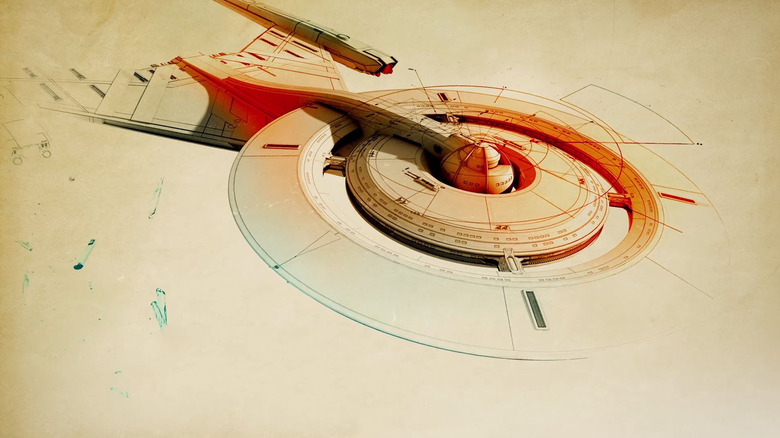
Music: "Star Trek: Discovery" features another theme by Russo, and it's significantly more "Trek" than the theme to "Picard." It's rousing and exciting with big orchestral swells — exactly the things that belong in a "Star Trek" theme. While it's not as instantly recognizable as some of the classic "Trek" themes, it still fits right in among them.
Visuals: " Discovery " has an interesting opening sequence, with blueprints and design schematics animated around the U.S.S. Discovery. It all looks very cool, but a "Star Trek" opening without stars just doesn't have the same feeling. The series was trying to set itself apart and become a bold new kind of "Trek," so the move away from the standard "ship flying through space" visuals is understandable.
Trek Factor: The title sequence to "Star Trek: Discovery" feels tangential to "Trek" without being directly a part of it. The visuals and music both hew closer to the sharp designs of the Kelvin timeline films, but at least it still feels "Trek"-adjacent.
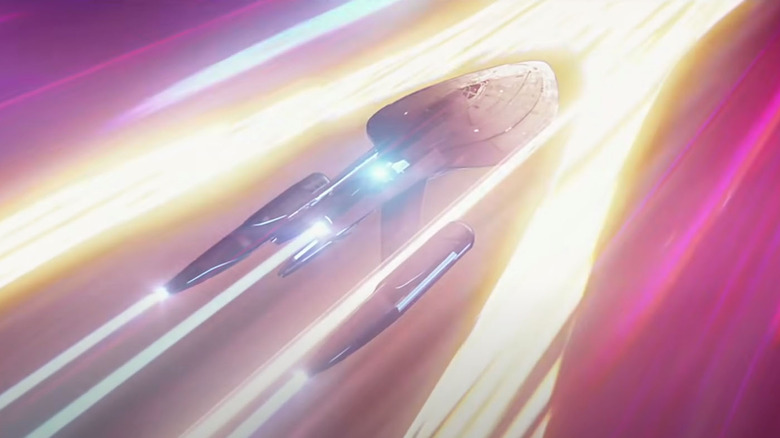
Music: The opening sequence for "Star Trek: Prodigy" is scored by Michael Giacchino, who also composed the scores for the three Kelvin-timeline films starting with "Star Trek" in 2009. It's a rousing theme that sounds a little more "Star Wars" than "Star Trek," but since "Prodigy" is for kids , that whimsical, fantastical sound kind of fits. It's not the best "Star Trek" theme, but it's still pretty cool, and definitely feels age-appropriate.
Visuals: The visuals are where "Star Trek: Prodigy" really shines. The animation is gorgeous as the ship flies around the galaxy, zipping around planets and asteroid belts before more abstract but beautiful things start flying around the ship itself. The whole thing is designed to be awe-inspiring and get kids excited, and I can only imagine how thrilled I would have been watching these credits as a child. We even get a version of Captain Janeway (Kate Mulgrew), made from stardust. How cool is that?
Trek Factor: This opening has all of the basic requirements for a quality "Star Trek" opening: a ship flying through space, a good theme, and some fun little visual treats, but it's still very clearly intended for kids and it's a little more fantastical than your average "Trek" opening. It's perfect for introducing young viewers to "Star Trek," but doesn't have the same nostalgic oomph as some of the other openings.
7. The Animated Series
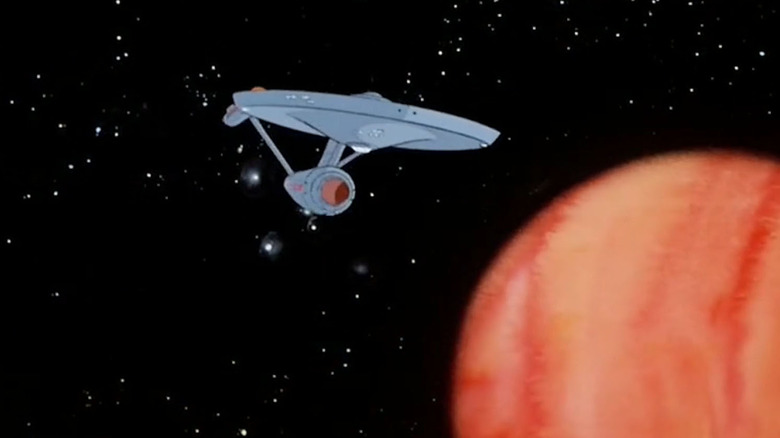
Music: Composers Ray Ellis and Norm Prescott took the theme from "Star Trek: The Original Series" and turned it into something more befitting an animated series. The theremin and orchestral arrangements are replaced by something significantly more poppy and upbeat, and when the titles actually show up and the big swell into the theme happens, it sounds more like "The Love Boat" than "Star Trek." It's a product of its time, though it's honestly incredibly charming.
Visuals: There's a little animated Enterprise zooming around the galaxy, mimicking the credits from "The Original Series" in animated format. It's old, cel-shaded, hand-drawn animation, and by golly, it's fun.
Trek Factor: William Shatner reads the original series voice-over, the theme is based on the original theme to some degree, and the animation is a near carbon-copy of the original series credits. You really can't get much more "Trek" than this, but it's just too much a product of its era to inspire more than amusement. If you want to feel like you've been teleported back in time to the 1970s, just watch this intro.
6. Deep Space Nine
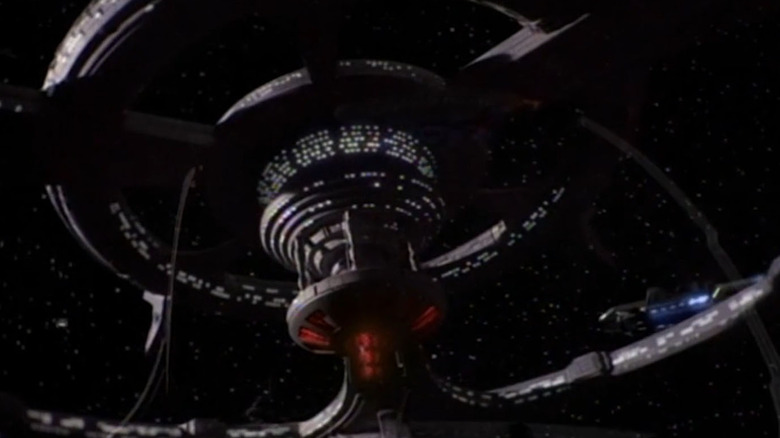
Music: The theme by Dennis McCarthy is great. It starts soft and builds into a big swell, as "Star Trek" themes are wont to do, but it stands just apart enough from the themes of the original series and "Next Generation" to clearly be its own thing. This is the first "Star Trek" opening without a voice-over, setting a precedent that would remain until "Star Trek: Strange New Worlds." Since "Deep Space Nine" was trying to take "Trek" in new directions, a different kind of opening makes a lot of sense.
Visuals: We see the space station Deep Space Nine, located near both the planet Bajor and the wormhole that leads to the Gamma Quadrant. One of the coolest things about the "Deep Space Nine" opening credits is the way they change as the seasons progress, adding the docked Defiant and occasionally other docked ships, representing various plot points in the series.
Trek Factor: The lack of a voice-over (and Avery Brooks as Captain Sisko could have probably done a pretty cool one) and sheer length of this intro (it's nearly two minutes) unfortunately hold it back from being one of the best. "Star Trek: Deep Space Nine" may be my favorite "Trek" of them all, but its opening sequence just isn't quite as great as some of the rest.
5. Lower Decks
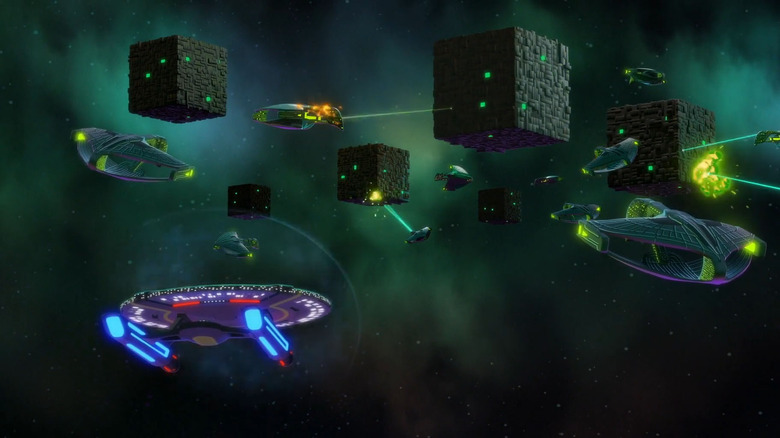
Music: The theme by Chris Westlake is pretty much perfect, mixing the sounds of many of the older series together to create something entirely new. From the opening chords, it's impossible to think of anything but "Star Trek." "Star Trek: Lower Decks" is a comedy show, but there's nothing comedic about the score. It just rules.
Visuals: "Lower Decks" uses the intro to show off the U.S.S. Cerritos, which doesn't get much screen time in the short episodes. We see it going on a bunch of missions and getting pelted by all kinds of space debris, which highlights the comedic aspect of the show. When we get a view looking down from above the ship, however, and we can read the ship's name and designation, it's fabulously nostalgic.
Trek Factor: Despite being a cartoon comedy series , the opening to "The Lower Decks" still feels like "Star Trek." It's both a throwback and something new, which is what all the best "Star Trek" tends to be.
4. The Original Series
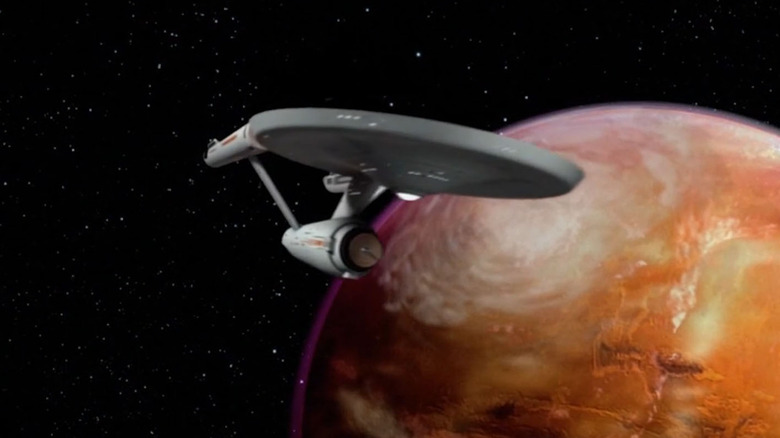
Music: The original theme by Alexander Courage is what started it all, inspiring the rest of the themes on this list in some way or another. (Except maybe "Enterprise," but that's on them.) The theme has the kind of a military march to it until Shatner finishes his voice-over and the title appears, then it softens and becomes a more melodic, joyful tune. The second half of the theme is exceptionally dated, but it evokes late 1960s television from the first note.
Visuals: Speaking of exceptionally dated, the images of the Enterprise flying around in outer space aren't exactly modern marvels of special effects. When you remember that they were creating these effects with models, careful camera placement, and matte paintings, they feel a little less silly and more impressive, but they just can't hold a candle to the CGI-created starships in today's "Trek."
Trek Factor: It's the original , there's no way to be any more "Trek."
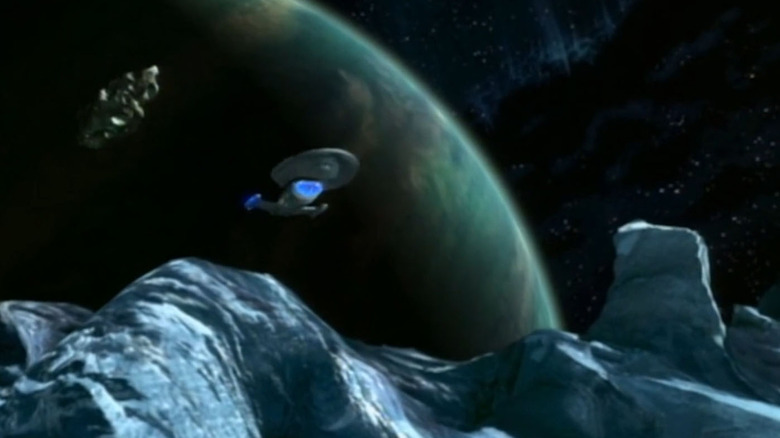
Music: Composer Jerry Goldsmith really knows how to write a great "Star Trek" theme. The theme for "Star Trek: Voyager" is one of the best, relishing in a big orchestral sound reminiscent of the themes from the original run of "Star Trek" films (probably because he helped with those, too). The theme to "Voyager" is spectacular, though not quite as catchy or memorable as the top two on the list.
Visuals: Yes, some of the CGI on the intro to "Voyager" looks a little dated, but it's not so outlandishly cartoonish that it detracts from the overall impression, which is that "Voyager" voyages. We see the ship zip around space, exploring planets, asteroid fields, and more, and it's really the first "Star Trek" opening that gave a real idea of the scope of Starfleet's exploration. We had seen the Enterprise zooming through space and around a few planets, and we had seen Deep Space Nine chilling next to Bajor, but this was the first time we got to see the full capabilities and range of a Federation starship in the opening credits.
Trek Factor: Pretty much the only thing holding " Voyager " back is the lack of a voice-over, because I need my captain to tell me the mission every episode, darn it!
2. Strange New Worlds
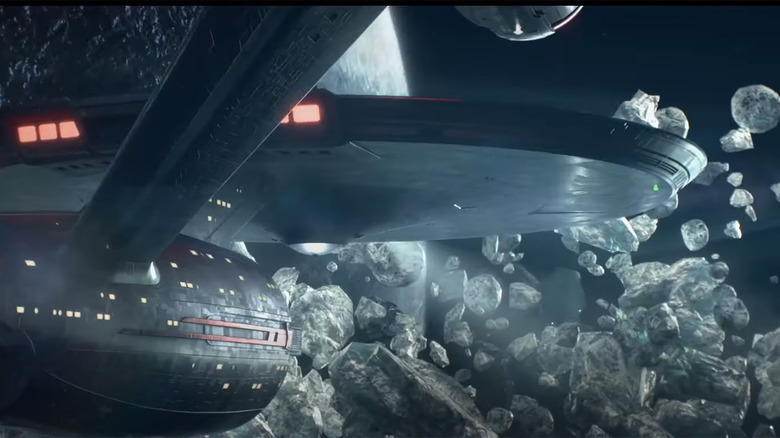
Music: Composer Jeff Russo got a lot of practice writing "Star Trek" themes with his work on "Discovery" and "Picard," and it seems like he finally found the perfect vessel for his ideas in "Star Trek: Strange New Worlds." The theme to the new series has everything you could ask for from a "Star Trek" theme: orchestral swells and booms, hints of the original series theme, and even a theremin to give the end of the theme an otherworldly sound.
Visuals: The Enterprise gets to go on the kind of intro ride that Voyager did, exploring space and all of the various hazards it has to offer. The special effects are incredible, and the opening sequence is just gorgeous to watch.
Trek Factor: Starship bopping about the galaxy? Check. A smooth-voiced captain (Anson Mount as Christopher Pike) doing a voice-over monologue that starts with "Space... the final frontier"? Check. A theme that gets the blood pumping before delivering chills in its final moments? Check. "Star Trek: Strange New Worlds" is a throwback in many ways, but its opening proves that it's also updating and upgrading the old into something even more grand.
1. The Next Generation
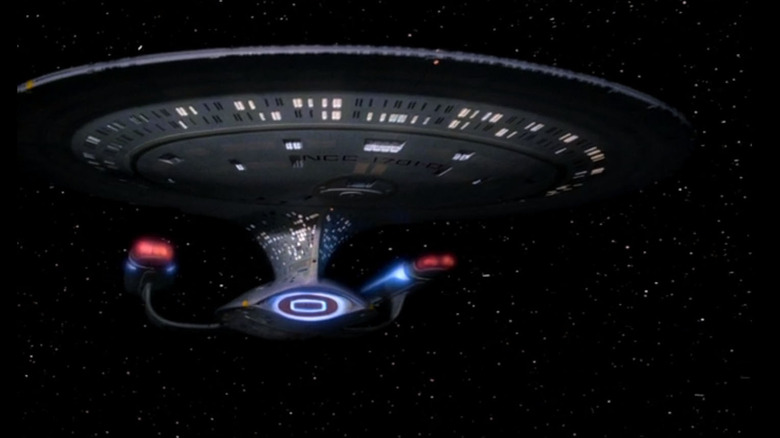
Music: The theme for "Star Trek: The Next Generation" is actually the theme from "Star Trek: The Motion Picture," composed by Jerry Goldsmith and based on the original score by Alexander Courage. When you ask the vast majority of "Star Trek" fans to think of a theme song, this is probably the one that's going to pop into their heads. It marries the original series, the movies, and "The Next Generation," making it the "Trek" theme for more than one generation.
Visuals: I'm not going to lie: the visuals for " The Next Generation " are pretty lackluster. The Enterprise zips around the stars a bit, but we don't see anything else out there in space, and the zipping gets a little repetitive. Thankfully, this is also one of the shorter intros, so it's easy to just focus on the killer theme music and Patrick Stewart's phenomenal opening voice-over.
Trek Factor: If Stewart doing the whole "these are the voyages of the starship Enterprise" thing followed by Goldsmith's theme doesn't get your heart pumping and the hair on your arms standing on end, you might be a Borg. This is "Star Trek" at its most "Star Trek," which is why it's the best opening of all of the series.
- The Original Series
- The Animated Series
- The Next Generation
- Deep Space Nine
- Strange New Worlds
- Lower Decks
- Star Trek Movies
- TrekCore on Twitter
- TrekCore on Facebook

- robert bonchune
- USS Voyager
Related Stories
Polar lights reveals new 1:1000-scale uss voyager model kit, plus: 1:1000-scale uss excelsior returns, eaglemoss to feature upcoming star trek merch at sdcc, eaglemoss reveals next bonus star trek ship models, search news archives, new & upcoming releases, featured stories, star trek: starfleet academy begins production in toronto, video preview: factory entertainment’s upcoming star trek phaser and medical tricorder prop replicas, interview — exploring star trek: prodigy season 2 with creators kevin & dan hageman (spoiler alert).
TrekCore.com is not endorsed, sponsored or affiliated with Paramount, CBS Studios, or the Star Trek franchise. All Star Trek images, trademarks and logos are owned by CBS Studios Inc. and/or Paramount. All original TrekCore.com content and the WeeklyTrek podcast (c) 2024 Trapezoid Media, LLC. · Terms & Conditions

Star Trek's Best Voyager Episodes
E verything about Star Trek: Voyager was a risk when the series debuted following the end of Star Trek: The Next Generation , an incredibly popular series. The flagship show of the nascent United Paramount Network, Captain Kathryn Janeway and her crew faced familiar struggles from fans. Their story, however, took the Star Trek universe to a new part of the galaxy. The Delta Quadrant hosted never-before-seen alien species and was the backyard of the Borg.
Through syndication and wide streaming access, Star Trek: Voyager is now regarded as a classic of this universe's second wave. Voyager finished its journey strong, and the addition of Seven of Nine -- a human drone rescued from the Borg collective -- changed the series for the better. Now in the third wave of the franchise, Seven of Nine is the captain of the USS Enterprise-G, and Janeway is now a Vice Admiral leading the young cadets of Star Trek: Prodigy . Below are the episodes that best showcase why Voyager is among Star Trek's most beloved series.
This Live-Action Star Trek Character is Quietly Crushing it In Star Trek: Prodigy
Star Trek: Prodigy introduces a new generation of fans to a new generation of characters, but one live-action legacy hero is crushing her role.
'Equinox' Showed What Happens When Starfleet Is Stranded and Goes Bad
The episode is a testament to how good a captain kathryn janeway is.
While in the Delta Quadrant trying to make their way back to Earth, the USS Voyager encountered another Starfleet vessel, the titular USS Equinox led by Captain Rudolph Ransom (who may or may not be related to Lower Decks ' Ransom). This ship had a much smaller crew and faced much harsher struggles in their journey across the Delta Quadrant. That the USS Voyager even caught up to them signified that, since the Equinox crew was pulled into the Delta Quadrant by the Caretaker earlier.
At first, the Voyager crew was overjoyed to find another friendly ship in the quadrant, but it turns out the Equinox was not as friendly a ship. While the crew had many flaws, their greatest offense was capturing and killing aliens from another dimension to boost their power. After the Equinox crew could no longer hide their crimes, the two Starfleet vessels went to war with one another. The two-part episode highlights just how dangerous and impossible the task before Captain Janeway and her crew was on Voyager , and how much more impressive it was they adhered to Starfleet values. (Mostly.)
'Death Wish' Brought the Q Continuum to Life In a New Way for Star Trek
The next generation inaugural alien species thrived on voyager (except for one of them).
The Q Continnuum was introduced in the pilot episode of Star Trek: The Next Generation , with Jon De Lancie playing the god-like aliens. However, "Quinn," played by Gerrit Graham, visits the USS Voyager to ask for asylum from the other Q. The reason? He wants to be allowed to die. Q are immortal endless beings ( at least until Picard Season 2 ), and Quinn was tired of immortality. Q assembles a group of people Quinn helped, including both Isaac Newton and Commander William Riker. Janeway is torn between what to do, because while she wants to grant Quinn asylum, she doesn't condone his desire for death.
This episode was great for two reasons. The first is because it's the classic kind of moral quandry that Star Trek does well, and the issue of the right for a person to end one's own life doesn't get more complex. The second reason this episode is a favorite among fans is because it begins to expand the Q Continuum beyond just the character from TNG . Future episodes would introduce other members of the continuum, a civil war, and Q's son. Still, it all started with "Death Wish," and the Q who chose to end his own existence just to see if anything lay beyond.
'Pathfinder' Is an Emotional Episode Starring Two TNG Legacy Characters
Reg barclay brought starfleet to voyager before the ship made it home.
Reginald Barclay was a weird member of the USS Enterprise crew who had an addiction to the holodeck , specifically losing himself in the fantasy worlds they created. Counselor Deanna Troi helped Barclay move past this, and he eventually left the ship. However, in the interim, Barclay became obsessed with finding the USS Voyager after it was lost. In this episode, he creates a holographic version of the ship where he behaves like a different person with his holographically-created Voyager crew. While that alone is interesting enough to sustain a fun episode of Star Trek , his obsession with Voyager was about opening a channel of communication.
Throughout the episode, Barclay is ordered to stop trying to contact the ship using the "MIDAS Array," a network of sci-fi satellites he wanted to use in an unorthodox way. After being sanctioned by his superior officer, Troi even takes leave from the Enterprise to help him deal with what's perceived as a holo-addiction relapse. However, Barclay ignores orders and keeps working on the project, even using the the holographic Voyager crew to try to stop Starfleet security from arresting him. The final scene, in which Barclay is proven right and does make contact with the ship is one of Star Trek: Voyager 's most emotional moments.
'Tinker, Tenor, Doctor Spy' Was a Big Episode for Voyager's Holographic Doctor
A concept introduced in this episode also played out on star trek: prodigy.
While Star Trek has more than one sentient holographic character, the Doctor on Voyager was the first. One reason he grew and evolved is because, like humans do all the time, he was able to alter his own programming. In "Tinker, Tenor, Doctor, Spy," he takes his first steps towards becoming a fiction writer , by writing new subroutines that allow him to daydream. He imagines himself as heroic in his fantasies, particularly as the Emergency Command Hologram. When a group of aliens called the Hierarchy are about to attack the USS Voyager, Janeway allows the Doctor to become his most heroic self.
As most Doctor-centric episodes were, "Tinker, Tenor, Doctor, Spy" is light-hearted and comedic. However, the episode also showcases just how much the Doctor grew since his first appearance as a surly, temporary-use holographic doctor. The Doctor has plenty of genuinely heroic moments, but in this episode he feels like a hero. Also, if Star Trek: Prodigy gets a Season 3 , the USS Prodigy will be led by a holographic commanding officer, though this one is modeled on Janeway herself.
'Otherwise, Why Bother?': Star Trek's Kate Mulgrew Reveals Conditions for Live-Action Janeway Return
Kate Mulgrew would be willing to reprise her iconic role of Kathryn Janeway under certain conditions.
'Relativity' Took Seven of Nine On an Adventure Into Voyager's Past
It's a classic time-travel episode of second-wave star trek.
In "Relativity," Seven of Nine is recruited by Starfleet time agents in the 29th Century, a concept that appeared again in both Enterprise and Star Trek: Discovery . Some time-traveling scamp planted a bomb on the USS Voyager, destroying it and changing the timeline. Because the bomb was hidden from the normal visual light spectrum, only Seven of Nine's Borg ocular implant allowed her to see the device. Because it's time-travel, she luckily gets more than one chance to solve the problem, resulting in scenes where the USS Voyager is destroyed.
The episode is one of many time-travel Star Trek episodes , but it a rare occurrence where the jumping through time is authorized by Starfleet. The ending also incorporates an interesting, and troubling, idea where the would-be bomber is arrested and detained before he actually committed his crime. Also, since Seven of Nine only joined the show in Season 4, it allowed her to go back and interact with earlier versions of the characters before she arrived on board.
'Distant Origin' Is the Kind of Social Allegory Star Trek Does Best
Voyager is caught up in a tale about scientific truth, immigration and acceptance.
The only episode on this list before Seven of Nine joined the crew, "Distant Origin" is representative of what Star Trek does best . It's a high-concept story about scientific exploration and the ways entrenched powers oppress the truth and those who seem "lesser" than them . The Voth are a superior race of intelligent beings that evolved tens of millions of years in Earth's past and took the stars.
The titular theory threatens the social order of the Voth, and the idea that they have a right to oppress others because they are "the first race" in their sector of space. Ironically, the episode spends much of its time away from the USS Voyager. It's not really their story, but rather the story of the Voth scientist facing punishment for violating "doctrine."
'Dark Frontier' Reveals Seven of Nine's Human Past and Importance to the Borg
This episode ties voyager to first contact and the next generation.
A feature-length two-part episode, "Dark Frontier" brings the Borg Queen to television for the first time since the character was created for Star Trek: First Contact . It also reveals how Annika Hansen and her parents came to be assimilated by the Borg. Part-heist story and part "mythology episode," which gives viewers a courtside view to how the Borg assimilate a species.
The USS Voyager plans to steal some Borg technology to help them get to Earth more quickly, but it's trap to recapture Seven of Nine. The Borg Queen reveals that Seven of Nine was "allowed" to leave the collective, and her recapture is meant to make her the human face of the Borg invasion of Earth, just as Locutus (Jean-Luc Picard) and Vox (Jack Crusher) were meant to be. In rescuing Seven of Nine, Captain Kathryn Janeway proves herself to be the Borg's biggest threat .
'Drone' Is a Perfect Blend of Star Trek Weirdness and Character Study
A high-concept voyager episode with a deeply emotional ending.
In "Drone," the holographic Doctor and Seven of Nine have a baby, of sorts. Originally bound to sickbay and the holodecks, the Doctor was given a 29th Century mobile emitter by Henry Starling. A transporter accident blends Borg "nanoprobes" with this technology creating a 29th Century Borg drone, just without a collective. He names himself "One," becoming something like a son to Seven of Nine.
One accidentally signals the Borg collective, which shows up to assimilate him and the USS Voyager. One is curious about his people, yet he's fully an individual . First, he helps the crew fight the Borg cube, but even his 29th Century know-how can't match the cube's raw firepower. He sacrifices himself in truly epic fashion, saving the ship but breaking Seven of Nine's heart .
'Endgame' Is the Epic Series Finale for Voyager and the Borg
Janeway brings the crew home and defeats star trek's worst enemy.
While everyone from fans to some of the cast lament the series finale of Star Trek: Voyager didn't show the ship actually arriving on Earth, it's still a fantastic finale. It begins many years after the previous episode, when the USS Voyager does arrive on Earth. Now a Vice Admiral, Janeway travels back in time with a plan to bring the ship and immobilize the Borg. All it will cost her is her life.
The beginning of the finale shows a version of the crew's future, though not everyone made it to Earth. The Elder Janeway's plan is ambitious and takes the ship right into the heart of the Borg society. While her younger counterpart gets her ship home, the elder Janeway has a final showdown with the Borg Queen. "Endgame" is full of spectacle appropriate for a series finale, while not sacrificing attention on the characters fans loved .
Star Trek: Voyager Actor Weighs in on Controversial Tuvix Debate
Star Trek: Voyager's Tuvix actor Tom Wright shares his opinion on whether Janeway made the right decision about his character's fate.
'Year of Hell' Is an Epic Two-Part Struggle for Survival
A year-long episode of star trek: voyager was almost a whole season.
The "Year of Hell" is a two-part episode that, according to Star Trek Voyager: A Celebration , could've lasted for an entire season. The episode centers on a new species called the Kremin, who developed a "timeship" that could erase entire civilizations from history. The captain and lead scientist, Annorax , continues these temporal incursions and sets his sights on the USS Voyager.
The two-part episode takes place over an entire year, with the USS Voyager and the Krenim engaging in a running war. The ship is damaged, the crew is battered and demoralized. The resolution resets the series' status quo. Had the fallout from this taken a full season, the show might have gotten too dark. This two-part epic is just enough "hell" to make this episode a classic instead of "the one where the season started to go downhill." The Krenim and the idea of the "Year of Hell" was mentioned in Season 3's "Before and After," when Kes visited a possible future.
'Timeless' Is About the Death and Resurrection of the USS Voyager
The survivors of the uss voyager break the prime directive to rewrite history.
Time travel is a Star Trek staple , and Voyager featured a lot of it. In "Timeless," select members of the crew survive after the USS Voyager is destroyed. The episode was directed by LeVar Burton who also appeared as Captain Geordi La Forge from the alternate future. As the surviving crew tries to change the past, La Forge has to stop them from violating the "Temporal Prime Directive."
Along with being a dark look at the future, the episode is emotionally heavy, especially for Chakotay and Harry Kim. The latter blames himself for the accident that destroyed the ship. He is determined to fix that mistake. Even though he's successful, the episode ends on a down note as the elder Kim sends a message to his younger self.
'Message In a Bottle' Brings Voyager One Step Closer to Home
The emergency medical holograms prove their mettle as starfleet officers.
The Romulans appear in "Message In a Bottle," one of the rare times a classic Star Trek alien species appears in Voyager other than the crew. The ship discovers a massive sensor array, and Seven of Nine sends the Doctor to another Starfleet vessel on the edge of Federation space. The array is the bottle, and he is the message. However, the ship is experimental and has been overtaken by Romulans.
The Doctor meets the Mark II version of the Emergency Medical Hologram used by Starfleet, and the irascible pair have to take on the Romulans. Along with being a thrilling episode in its own right, "Message In a Bottle" was important to the overall story. It's the first time the USS Voyager is able to make contact with Starfleet, letting them know the ship was not destroyed .
Star Trek: Prodigy Is the Last Hope for Janeway and Chakotay Shippers
Star Trek: Prodigy brought Voyager characters Kathryn Janeway and Chakotay back into their story and there is a chance for the romance fans never got.
'Living Witness' Is Unlike Any Other Star Trek Episode
The closest the uss voyager ever got to the 'mirror universe'.
Another Doctor-heavy episode, "Living Witness" is a truly unique premise, not just for Voyager but Star Trek itself. Much of the episode is set far in the future from the 24th Century, in a society where the USS Voyager, Starfleet and Captain Janeway have become myth. A copy of the Doctor's program is discovered, and a researcher at the museum reactivates him.
The holographic recreations of the USS Voyager are like Mirror Universe versions of the characters fans know. As the Doctor tries to set the record straight, it causes social upheaval in the society. Ultimately, he urges the researcher to deactivate him and maintain peace on his planet, at the cost of the truth . Though, an even further future ending scene shows the truth eventually came out.
'Scorpion' Represents an Ending and a Beginning for Voyager
These episodes introdce the borg and seven of nine.
The end of Star Trek: Voyager Season 3 and start of Season 4 began the ship's frequent conflicts with the Borg. The second part of the two-part episode also introduces Seven of Nine, as Captain Janeway makes an alliance with the Borg. They encounter a new alien, species 8472 from a dimension of "fluidic space" with no other lifeforms. They are immune to assimilation.
The first episode cold open is short but powerful. A pair of Borg cubes descend on the unseen species 8472 and are destroyed. "Scorpion" is as consequential to Voyager as the classic Season 3 to 4 " Best of Both Worlds " was to The Next Generation . Unlike the USS Enterprise, which only had to deal with a single Borg cube, the USS Voyager was in the heart of Borg space.
'Blink of an Eye' Is a Classic Star Trek Episode with a Unique Concept
The top-rated star trek: voyager episode encompasses everything the franchise does best.
The USS Voyager finds itself stuck in the orbit of a planet that has a strange time variance, due to a heavy concentration of "chronaton particles." While the ship spends less than a week in this predicament, the time differential means the ship is viewed in the sky by the planet's indigenous population for a millennia. The "skyship" is the subject of myth, religion, pop culture and serves as an impetus for scientific advancement.
Because of the Prime Directive , the crew avoids making contact with the population, even though the presence of the ship causes frequent planetwide earthquakes. However, as the society advances, explorers from the planet come to the ship. It's a classic Star Trek episode despite being so unique. Just like "Distant Origin," it deals with the idea of scientific exploration, respect for other cultures or societies, and the propensity for any species to turn to violence when faced with the unknown .
Star Trek: Voyager is available to own on Blu-ray, DVD, digital and streams on Paramount+ and Pluto TV.
Star Trek Voyager
Pulled to the far side of the galaxy, where the Federation is seventy-five years away at maximum warp speed, a Starfleet ship must cooperate with Maquis rebels to find a way home.
Release Date January 16, 1995
Cast Majel Barrett, Jennifer Lien, Garrett Wang, Tim Russ, Robert Duncan McNeill, Roxann Dawson, Kate Mulgrew, Jeri Ryan, Ethan Phillips, Robert Picardo
Main Genre Science Fiction
Genres Action, Science Fiction, Adventure
Rating TV-PG
Creator Rick Berman, Michael Piller and Jeri Taylor
Number of Episodes 168


COMMENTS
The complete, original opening sequence to the television show Star Trek Voyager. Notice the inclusion as Jennifer Lien as Kes, which indicates this was take...
Over a thumb up and a subscription for our efforts, we would be very happy.But leave the bell quiet. ;-)
The best of all the title sequences, now in HD. This is a re-creation from scratch, including building the ship. I started this in 2017. It has been a long p...
The Coldest Line In All Of Star Trek History r/voyager • As often as the Holodeck malfunctions, you would think they would have a dead-man's switch protocol that checks if safeties are on (unless manually turned off) and that it is working properly every 10 seconds and if not attempts to shut down then bellows to all that there is a problem.
The opening title sequence for Star Trek: Voyager highlighted the series' hero starship, the USS Voyager, traversing spatial phenomena made possible with the latest in contemporary CGI modeling. The sequence was designed by Dan Curry, with the title theme composed by Jerry Goldsmith. Main Title Theme file info (composed by Jerry Goldsmith) The sequence was nominated for an Emmy for Outstanding ...
Now, without further ado, the Star Trek Voyager Opening Theme Song. We sing this, as obnoxiously & loudly as possible, every time it comes on. Be amazed that we've shared this private family moment with ya'll. And away we go... Responding to the many requests for them, here are the song lyrics: Dun-Du-Dun! Look, There Goes the Ship! Look, it ...
The opening sequence for Star Trek: Voyager in 4K with reimagined music and a tribute to all involved. ... (kind of like that scene from The Clone Wars in which the younglings build theirs, but in a more photorealistic way). I called it "Assembled". Hope you enjoy! ... Star Trek DS9 S07E04 "Take Me Out To The Holosuite" is the best feel-good ...
The opening scene shows the Cardassians pursuing a smaller Maquis spacecraft that escapes into the Badlands, a volatile nebula. The Cardassian vessel is damaged by a plasma storm and the Maquis ship is caught in a displacement wave. ... In 2015, a Star Trek: Voyager binge-watching guide by Wired suggested this episode could not be skipped. [25 ...
Not knocking this 4K intro in any way, I love it. EC Henry did a good video analysing that planet scene ( link here ). He does a lot of great Star Trek and Star Wars stuff, including his own ST fan film in the works, I highly recommend checking him out. so the conclusion is they found king kai planet.
Star Trek: Voyager . Star Trek Voyager Opening Title Sequence Recreated with CGI in 4k! ... . Star Trek Voyager Opening Title Sequence Recreated with CGI in 4k! Thread starter PixelMagic; Start date Aug 11, 2017; 1; 2; Next. 1 of 2 Go to page. Go. Next Last. PixelMagic Fleet Captain. Fleet Captain. Aug 11, 2017 #1 This guy did an amazing job! ...
Watch the iconic intro of Star Trek: Voyager, remastered to Full-HD by ScifiNewsDE and relive the journey of a lifetime! This video marks the beginning of th...
11. Star Trek: Enterprise Season 3-4 (2003-2005) Composed by Dennis McCarthy. Enterprise's theme song is the first (and last) time Star Trek uses a contemporary song for the opening. Dennis McCarthy scored the pilot episode. Executive producer Rick Berman promised something new for Star Trek's sixth spin-off series.
Star Trek: Voyager is the fifth Star Trek series. It was created by Rick Berman, Michael Piller, and Jeri Taylor, and ran on UPN, as the network's first ever series, for seven seasons in the USA, from 1995 to 2001.In some areas without local access to UPN, it was offered to independent stations through Paramount Pictures, for its first six seasons.The series is best known for its familial crew ...
The phrase was originally said by Captain James T. Kirk (William Shatner) in the original Star Trek series. "Where no man has gone before" is a phrase made popular through its use in the title sequence of the original 1966-1969 Star Trek science fiction television series, describing the mission of the starship Enterprise.The complete introductory speech, spoken by William Shatner as Captain ...
Attempting to emulate my heroes.If you would like to support the channel you can now do so with a Patreon donation from $2 a month, and get access to increme...
Star Trek Opening Credits Ranked. Paramount. By Danielle Ryan May 7, 2022 8:00 am EST. Every "Star Trek" series has a different theme and open credits sequence, all influenced by those that have ...
It's actually half CGI, half miniature. Voyager's CG chief said so: The opening title sequence for Star Trek: Voyager had six distinct segments - three used motion-control shots of the studio model (here, here, and here), and three were made with Amblin Imaging's Voyager model (here, here, and here).
We're wrapping up Voyager Week with a very special behind-the-scenes article from former Star Trek: Voyager Senior CG Supervisor Rob Bonchune. Rob's tenure at the franchise led him to work on all three CG-heavy Trek shows: Deep Space Nine, Voyager and Enterprise, eventually becoming the Senior CG supervisor for the last seven years of the […]
The iconic opening to Voyager (aka Star Trek: Voyager) opening theme (1995-2001)Theme music composer Jerry GoldsmithOriginal network: UPNProduction company(s...
364 votes, 99 comments. 657K subscribers in the startrek community. Now on Lemmy at https://startrek.website/ - here's why…
The final scene, in which Barclay is proven right and does make contact with the ship is one of Star Trek: Voyager's most emotional moments. 'Tinker, Tenor, Doctor Spy' Was a Big Episode for ...
The opening titles to STAR TREK:VOYAGER -- now remastered to 4K/48fps UHD, fresh from the Tales From SYL Ranch DARKROOM! 👍 🔔Original Release Date: Janu...
A casual, constructive, and most importantly, welcoming place on the internet to talk about Star Trek. Robert Picardo reenacts the opening scene from 'Voyager' episode "Virtuoso". Archived post. New comments cannot be posted and votes cannot be cast. This is from Tinker, tenor, doctor spy. He even says so at the end. 😉.